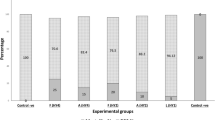Abstract
Red sea bream iridovirus (RSIV) and Viral hemorrhagic septicemia virus (VHSV) are the most important viral marine pathogens in South Korea because RSIV and VHSV infect and cause high mortality rates in major fish species such as Paralichthys olivaceus and Sebastes schlegelii. These viruses can be transmitted both vertically and horizontally, and early diagnosis is imperative. In this research, RSIV and VHSV viral genomes are detected by PCR-lateral flow assay (LFA). PCR-LFA is sensitive, capable of detecting a viral genome at a concentration of 2–200 fg/µL. Development of this detection method is very meaningful because LFA is simple, requiring a minimum of personnel training to perform. Additionally, LFA requires less time than other detection methods and can be an immediate detection tool that is indispensable in preventing rapid viral spread.






Similar content being viewed by others
References
Al-Hussinee L, Lumsden J. Detection of VHSV IVb within the gonads of Great Lakes fish using in situ hybridization. Dis Aquat Organ. 2011;95(1):81–6.
Beachy RN, Loesch-Fries S, Tumer NE. Coat protein-mediated resistance against virus infection. Annu Rev Phytopathol. 1990;28:451–74.
Duncan R, Kourout M, Grigorenko E, Fisher C, Dong M. Advances in multiplex nucleic acid diagnostics for blood-borne pathogens: promises and pitfalls. Expert Rev Mol Diagn. 2016;16(1):83–95.
Einer-Jensen K, Ahrens P, Forsberg R, Lorenzen N. Evolution of the fish rhabdovirus viral haemorrhagic septicaemia virus. J Gen Virol. 2004;85(5):1167–79.
Emmenegger EJ, Moon CH, Hershberger PK, Kurath G. Virulence of viral hemorrhagic septicemia virus (VHSV) genotypes Ia, IVa, IVb, and IVc in five fish species. Dis Aquat Organ. 2013;107(2):99–111.
Hoffmann B, Beer M, Schütze H, Mettenleiter TC. Fish rhabdoviruses: molecular epidemiology and evolution. In: Fu ZF, editor. The World of rhabdoviruses. Berlin: Springer; 2005. p. 81–117.
Hwang J, Suh S-S, Park M, Cho S-H, Lee S, Lee T-K. Rapid and sensitive detection of iridovirus by loop-mediated isothermal amplification (LAMP). Afr J Microbiol Res. 2015;9(6):382–7.
Hwang J, Park SY, Suh S-S, Park M, Lee S, Lee T-K. Efficient detection of pathogen virus in sand dabs, Paralichthys olivaceus using loop-mediated isothermal amplification (LAMP). Acta Oceanol Sin. 2016;35(8):44–50.
Hwang JY, Lee S, Priyathilaka TT, Yang H, Kwon H, Kwon MG, et al. Phylogenetic analysis and duplex RT-PCR detection of viral hemorrhagic septicemia virus in olive flounder (Paralichthys olivaceus) from Korea. Aquaculture. 2018;484:242–9.
Inada M, Handayani CR, Kawato Y, Mekata T, Yuasa K, Miwa S. Modification of PCR program for detection of infectious myonecrosis virus. Fish Pathol. 2016;51(4):210–2.
Kim R, Faisal M. Experimental studies confirm the wide host range of the Great Lakes viral haemorrhagic septicaemia virus genotype IVb. J Fish Dis. 2010;33(1):83–8.
Kim W-S, Jung S-J, Kim J-O, Kim D-W, Kim J-H, Oh M-J. Genetic positioning of Korean viral hemorrhagic septicemia virus (VHSV) from cultured and wild marine fishes. J Fish Pathol. 2011;24(1):1–9.
Kim K, Hwang S, Cho M, Jung S, Kim Y, Jeong H. A natural infection by the red sea bream iridovirus-type Megalocytivirus in the golden mandarin fish Siniperca scherzeri. J Fish Dis. 2018;41(8):1229–33.
Kim HJ, Cuenca A, Olesen NJ. Validation of a novel one-step reverse transcription polymerase chain reaction method for detecting viral haemorrhagic septicaemia virus. Aquaculture. 2018;492:170–83.
Kurita J, Nakajima K, Hirono I, Aoki T. Polymerase chain reaction (PCR) amplification of DNA of red sea bream iridovirus (RSIV). Fish Pathol. 1998;33(1):17–23.
Lumsden JS, Morrison B, Yason C, Russell S, Young K, Yazdanpanah A, et al. Mortality event in freshwater drum Aplodinotus grunniens from Lake Ontario, Canada, associated with viral haemorrhagic septicemia virus, Type IV. Dis Aquat Organ. 2007;76(2):99–111.
Oh S-Y, Oh M-J, Nishizawa T. Potential for a live red seabream iridovirus (RSIV) vaccine in rock bream Oplegnathus fasciatus at a low rearing temperature. Vaccine. 2014;32(3):363–8.
Poddar SK. Influenza virus types and subtypes detection by single step single tube multiplex reverse transcription-polymerase chain reaction (RT-PCR) and agarose gel electrophoresis. J Virol Methods. 2002;99(1):63–70.
Sun Y, Chen J, Li J, Xu Y, Jin H, Xu N, et al. Novel approach based on one-tube nested PCR and a lateral flow strip for highly sensitive diagnosis of tuberculous meningitis. PLoS ONE. 2017;12(10):e0186985.
Taboada L, Sánchez A, Pérez-Martín RI, Sotelo CG. A new method for the rapid detection of Atlantic cod (Gadus morhua), Pacific cod (Gadus macrocephalus), Alaska pollock (Gadus chalcogrammus) and ling (Molva molva) using a lateral flow dipstick assay. Food Chem. 2017;233:182–9.
Tu P-A, Shiu J-S, Lee S-H, Pang VF, Wang D-C, Wang P-H. Development of a recombinase polymerase amplification lateral flow dipstick (RPA-LFD) for the field diagnosis of caprine arthritis-encephalitis virus (CAEV) infection. J Virol Methods. 2017;243:98–104.
Wu W, Zhao S, Mao Y, Fang Z, Lu X, Zeng L. A sensitive lateral flow biosensor for Escherichia coli O157: H7 detection based on aptamer mediated strand displacement amplification. Anal Chim Acta. 2015;861:62–8.
Yetisen AK, Akram MS, Lowe CR. Based microfluidic point-of-care diagnostic devices. Lab Chip. 2013;13(12):2210–51.
Acknowledgement
This research was supported by the Bio & Medical Technology Development Program of the National Research Foundation (NRF) funded by the Ministry of Science & ICT (NRF-2017M3A9E407275).
Author information
Authors and Affiliations
Corresponding author
Ethics declarations
Conflict of interest
The authors declare that they have no conflict of interest.
Additional information
Publisher's Note
Springer Nature remains neutral with regard to jurisdictional claims in published maps and institutional affiliations.
Rights and permissions
About this article
Cite this article
Seo, H., Kil, EJ., Fadhila, C. et al. Rapid diagnosis of two marine viruses, red sea bream iridovirus and viral hemorrhagic septicemia virus by PCR combined with lateral flow assay. VirusDis. 31, 251–256 (2020). https://doi.org/10.1007/s13337-020-00577-z
Received:
Accepted:
Published:
Issue Date:
DOI: https://doi.org/10.1007/s13337-020-00577-z




